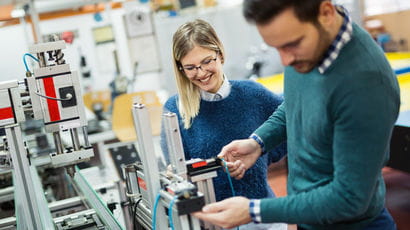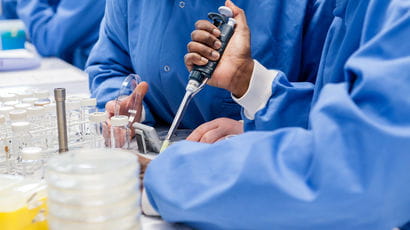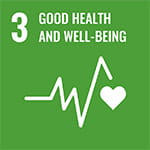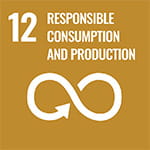Biofilm model systems in healthcare
A system developed at UWE Bristol to measure the growth rate of microbes has been used by companies to help identify and develop dressings for wounds and products to tackle bad breath.
Research led by Professor John Greenman has developed a technique that can measure the growth and behaviour of microbes, the ‘matrix perfusion flow system’. The microbes are grown as a biofilm on a supporting matrix made of loosely packed interconnecting strands of cellulose and supplied with a flow (‘perfusion’) of nutrients.
If the cells have been engineered to glow (bioluminesce), measurements of the emitted light can be used to monitor their growth. Alternatively, for bacteria taken from the mouth of a volunteer with halitosis, for example, Greenman’s team can measure the emissions of hydrogen sulphide and other volatile gases.
The biofilms grow on the matrix in much the same way as they would on the area of the body it is designed to simulate, whether the inside of the mouth or a wound, for example. The researcher can vary the conditions in which the cells grow – such as the acidity or composition of the nutrient – and observe the effects on the growth or metabolism of the microbes.
Mouthwash formulations
This has enabled the team to test the efficacy of formulations proposed for use as oral health products such as mouthwashes, tongue sprays and tooth gels. The biofilm cultures could be made to behave in a very similar way to real tongue-surface biofilms. Then, when the researchers change the conditions in controlled ways, they can watch what happens to the microbes as a result.
For example, between 2008 and 2013, tests performed by Greenman’s team informed the company GABA International (a subsidiary of Colgate-Palmolive) in its choices of formulations for mouthwashes, helping it decide which ones were priorities to take to market.
Similarly, Greenman and colleagues have worked with Givaudan, a company that provides flavours for oral care products. Givaudan has developed solutions identified using UWE Bristol’s approach and has sold them to major oral healthcare brands around the world, who have incorporated them into their well-known products used by millions of consumers every day.
Givaudan’s Vice President, Technology (North America) says that UWE Bristol’s in vitro model “has enabled us to increase speed to market through reduction in our flavour development time”. He says that sales of the consumer products in the period 2008-13 may be conservatively estimated at many millions of dollars, and adds “The bar has been raised in breath freshness and much can be directly attributed to the scientific and collaborative studies of Professor Greenman's research”.
The team has also conducted clinical trials of oral health products designed to eliminate bad breath in real human volunteers. The trials were carried out on behalf of an industrial client. Greenman and colleagues were able to show that a test product worked extremely well, giving the company the basis to develop it further, scaling up to full commercial manufacture. Under a new brand name, it is now distributed and sold internationally.
Testing prototype dressings for wounds
The team developed a new ‘gel diffusion’ flat-bed model to test films growing on flat surfaces. The resulting technique was able to simulate the progression of microbial colonisation of wounds. In real wounds, if this colonisation goes on to cause infection, it can substantially delay or even prevent healing, especially if the wound is complex.
In most cases there was little evidence as to whether antimicrobial dressings helped. The way these dressings had typically been assessed only applied to highly artificial conditions. To develop new dressings that were genuinely better at killing microbes, a new evaluation technique was needed to model the conditions found in real wounds. It would also need to be able rank how well proposed new dressings worked compared with each other.
Greenman’s team used their flat-bed model to test prototype dressings for industrial partner Insense Ltd and its later spin-out company Archimed Ltd. This approach succeeded in showing the product’s efficacy without the need for animal models and all the extra costs they would have entailed.
Insense’s founder says they approached Greenman because “we became aware of his excellent work on multi-species bacterial biofilms and cultures. It quickly became clear that he and his team were ideally suited to be our partners, not just to undertake routine testing but to develop a new, more meaningful and rational approach to testing wound dressings”.
UWE Bristol’s model gave them “compelling evidence of the superior efficacy of our products” which was “of great importance in the promotion of our products and in building a basis (together with clinical performance and cost effectiveness) for their acceptance and adoption by healthcare professionals and purchasing authorities. The products have been accepted on the National Formulary and are in use in various clinical centres in the UK and the Netherlands.”
Real public benefits
These are just a few examples of companies that have made direct use of UWE Bristol’s research findings in a commercial context, resulting in tangible and widespread benefits to consumers of healthcare products.
Contribution to the UN 2030 sustainable development goals
UWE Bristol is proud to align our research to the UN sustainable development goals. The above research aligns with the following goals:
Breaking research boundaries
We’re tackling the big issues of today and tomorrow head on. This is big, brave thinking for a better future. It’s research done well. Research with the power to transform lives, transform the future.
Breaking research boundariesYou may also be interested in

News
The latest news stories from across UWE Bristol.

Research centres and groups
Browse UWE Bristol's portfolio of research areas, expertise, staff and publications.


